

9 Tips To Apply Adult Learning Theory to eLearning. In this article I'll discuss how Knowles' 5 adult learning theory assumptions can be translated to modern day eLearning experiences, so that you can integrate the 4 principles of Andragogy into your eLearning course for maximum learner engagement and motivation. According to the renowned American educator, Malcolm Knowles there are 5 assumptions concerning the characteristics of adult learners, and 4 principles concerning adult learning (andragogy).
Despite the fact that Knowles' adult learning theory assumptions and principles were introduced in the 1980's, each can be utilized today to help eLearning professionals create more meaningful learning experiences for adult learners. WCAG 2.0 at a Glance. WAI: Strategies, guidelines, resources to make the Web accessible to people with disabilities Site Navigation W3C Home.
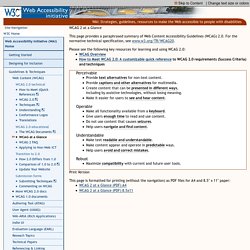
10 Tips for Creating Wildly Successful Infographics. Infographics are playing a larger role in visual storytelling efforts.

When they are thoughtfully designed, they provide attention-grabbing visuals that also help the reader better comprehend and remember the message. This added value to the reader often encourages further engagement and sharing. Based on my experience creating infographics that are used in PR Newswire’s press releases, blog posts and presentations, here are some best practices for designing infographics that drive results: Design BasicsThese tips can be applied to any design process to get the best end result.
Sketch first, polish later.Before you hop into Photoshop, Illustrator, etc., sketch out your ideas on some old-fashioned paper. Multi-Use Flexibility Infographics can take on many forms and be used in multiple channels. Align to your story. How People Learn: 8 Timeless Principles for Effective eLearning. How People Learn: 8 Timeless Principles for Effective eLearning Effective learning doesn’t require expensive technology and elaborated training sessions.
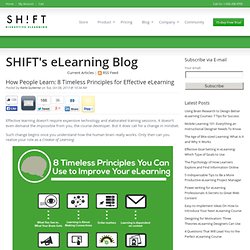
It doesn’t even demand the impossible from you, the course developer. But it does call for a change in mindset. Such change begins once you understand how the human brain really works. Only then can you realize your role as a Creator of Learning. What You See vs. What you see is not exactly what your brain gets. The good news is, you can also influence people to see things in a certain way, depending on how they are presented. Understand These 10 Principles of Good Design Before You Start Your Next eLearning Project. Understand These 10 Principles of Good Design Before You Start Your Next eLearning Project Wether you are just getting started with eLearning design and looking to get a better understanding of eLearning best practices, or you've been designing courses for a while and are trying to find ways of making your material more effective, considering the basics of visual design is key.

Design is too often overlooked by course developers, or otherwise misunderstood – some eLearning designers think that as long as their course "looks good," the visuals are sufficient. But graphical composition and design affect the way a learner takes in information, so giving a bit more thought to the visual layout of the pages of your course is an important part of eLearning best practices. Try these ten simple changes, and see the difference they make. 1. The placement of the elements on each page should flow naturally from one to the next in a progression that lends itself to the content you're teaching. 2. 3. Tips to Give Effective Feedback for Online Courses.
Good online courses provide feedback throughout the course.

The trick is making sure that it is meaningful and effective feedback. Here’s an approach that’s typical of a lot of elearning courses. We provide a few screens of information then a quick knowledge check to see what they know. Then provide some more screens of information with another quick knowledge check. At the end of it all, we have them complete a multiple choice quiz. Labelling Third Party Content in Creative Commons Licensed Material. This information sheet is for teachers who create or compile teaching resources and for e-learning and curriculum units who develop resources.
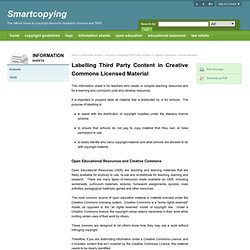
It is important to properly label all material that is distributed by or for schools. The purpose of labelling is: to assist with the distribution of copyright royalties under the statutory licence scheme, to ensure that schools do not pay to copy material that they own or have permission to use; to easily identify who owns copyright material and what schools are allowed to do with copyright material.
Open Educational Resources and Creative Commons Open Educational Resources (OER) are teaching and learning materials that are freely available for anybody to use, re-use and re-distribute for teaching, learning and research. The most common source of open education material is material licensed under the Creative Commons licensing system. The Australian Storyline. The Rapid eLearning Blog - Practical, real-world tips for e-learning success. Creating great interactive learning experiences requires a few core building blocks: relevant content, pull versus push, and real-world decisions.
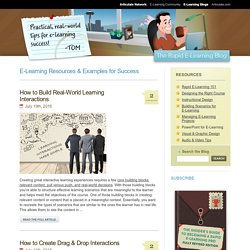
With those building blocks you're able to structure effective learning scenarios that are meaningful to the learner and helps meet the objectives of the course. One of those building blocks in creating relevant content or content that is placed in a meaningful context. Essentially, you want to recreate the types of scenarios that are similar to the ones the learner has in real life. This allows them to see the content in ... Read the full article. Downloads. Articulate Storyline - Showcase. Accident Investigation Demo by Rob Clark for the U.S.
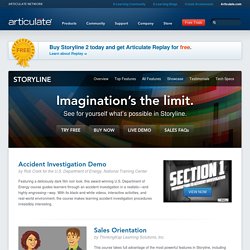
Department of Energy, National Training Center Featuring a deliciously dark film noir look, this award-winning U.S. Department of Energy course guides learners through an accident investigation in a realistic—and highly engrossing—way. Icons. The Wealthiest Americans Ever. E-Learning Heroes. Planning4elearning.wikispaces. This wiki has been created by Marlene Manto as an 'e-handout' to support sessions on Strategic Planning for e-Learning for managers and decision-makers.
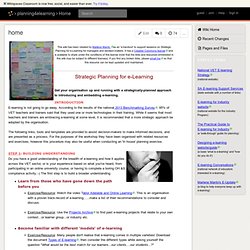
It has a Creative Commons license and is available to share under the conditions of this license (note that the links and resources embedded in this wiki may be subject to different licenses). If you find any broken links, please email me so that this resource can be kept updated and maintained. Build A Simple E-Learning Project Plan.
A successful elearning project requires good planning.
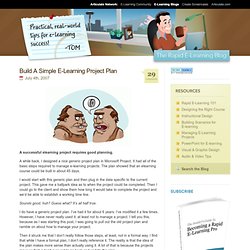
A while back, I designed a nice generic project plan in Microsoft Project. It had all of the basic steps required to manage e-learning projects. The plan showed that an elearning course could be built in about 45 days. I would start with this generic plan and then plug in the data specific to the current project. eLearning 101 Part 2: Planning. In eLearning Part 1: Introduction to eLearning you were introduced to the concepts of eLearning and approaches to learning. In eLearning Part 2: Planning eLearning, we will discuss planning and how to create a storyboard, the audio or script writing process and various methods of interactivity Before anything is put on paper, the audience for the training has to be determined.
Once you know who you're talking to and what their skill levels are, you can then begin the task of actually putting the training program together. Training design ideas from Cathy Moore. Training for 21st Century. Building Scenarios for E-Learning. Generally you have two types of courses. Some are all about pushing information out to the learners. And some focus on changing behavior and performance. Both have their roles in the world of elearning. Quick Start Guide for Online Student Success. Collaboration Ice. Central online applications 25 Feb 2013. 10 Tech Skills Every Educator Should Have. Google Tips, Tricks & Hacks. Online learning as a possible cost saving measure. Five Pedagogical Practices to Improve Your Online Course. Written by: Rob KellyPublished On: February 8, 2014 Because online courses have fewer opportunities for the spontaneous, real-time exchanges of the face-to-face classroom, online instruction requires a deliberate approach to design and facilitation.
As Bethany Simunich says, “Online, learning doesn’t happen by chance.” In an interview with Online Classroom, Simunich, associate director of online learning at Kent State University, offered the following techniques to improve an online course: 1. Vary the learning experiences. Using a backward design approach, Simunich has instructors consider what types of activities will enable students to demonstrate that they have achieved the course’s learning outcomes. Depending on those outcomes, the best approach might be an individual assignment or one that involves collaboration in small or large groups. 2.
The instructor needs to design the discussion to give students a way to enter the conversation. What is the purpose of this discussion? 3. 4. What is flipped classroom. How to Create a YouTube Channel. Articulate Storyline E-Learning Demos & Training Examples. Sales Orientation Sales Orientation by ThinkingKap Learning Solutions, Inc. View the Articulate Storyline example (See more examples in the Articulate Storyline showcase) View the interactive example → Periodic Table Periodic Table by Phil Mayor, Elearning Laboratory View the Articulate Storyline example (See more examples in the Articulate Storyline showcase) View the interactive example → U.S. U.S.
View the interactive example → Summary List of VET E-standards - Technical Standards - E-standards for Training. Flip the Perspective for Effective Course Design. You’re the site safety manager and arrive at company headquarters to find the workplace in disarray. Tables are knocked over, the place is littered with documents, and your cubicle is covered in slime. And you can’t find anyone in the building. Footage from the security cameras reveal that the site’s been overrun by aliens and all of the staff has been abducted. Simple Way to Write eLearning Quiz Questions.
eLearning & Training: How Long is Too Long? You can create the best-looking, most well-written eLearning lesson anyone has ever seen. But for the lesson to be effective, one of the most important things to keep in mind is that more does not mean better. If your lesson plays too long, you run the risk of losing the attention span of your learner and lowering the effectiveness of the lesson in general. 4 Tips for Creating Effective e-Learning Objectives for Yourself.
20+ Tips for Writing Great Quiz Questions and Response Options. If you’ve written quizzes in the past, you know how hard it is to write really great questions and realistic response options. It’s a tricky balance between something that’s an incorrect answer, but still plausible enough that the learner doesn’t dismiss it outright. To make sure you get the best quiz questions and response options possible, refer to this checklist of 20+ tips when writing your quizzes: By checking all of your quiz questions and response options against this checklist, you can greatly improve the quality of your quizzes, and improve your learner’s experience taking your quiz. ?action=relogin&new_loc=%2Fwebapps%2FBb-sites-course-creation-BBLEARN%2FcheckCourseEnrollment. Factsheet_eassessment. 30 Bite-Sized Writing Tips for Better eLearning Content. Why%20is%20writing%20for%20e-learning%20different%20(Apr%2006) Central : Resources4Biz - Elearning 101 - concepts, trends, applications. 10 Tips for Good Web Writing.
Building Scenario–Based e-Learning Courses. Educational Videos and Conceptual Objectives. This article provides guidance on developing videos for training objectives on conceptual knowledge. In particular it focuses on using animation, stories and other strategies to produce great videos.